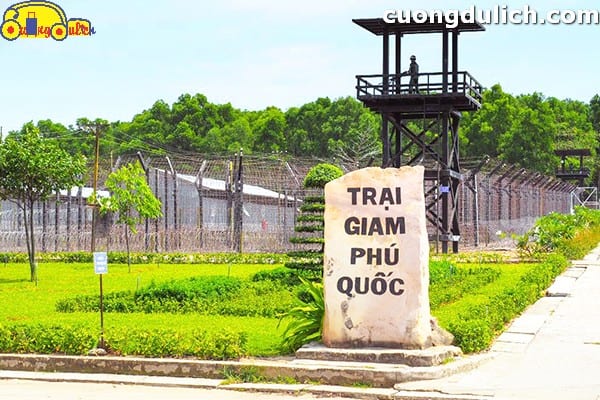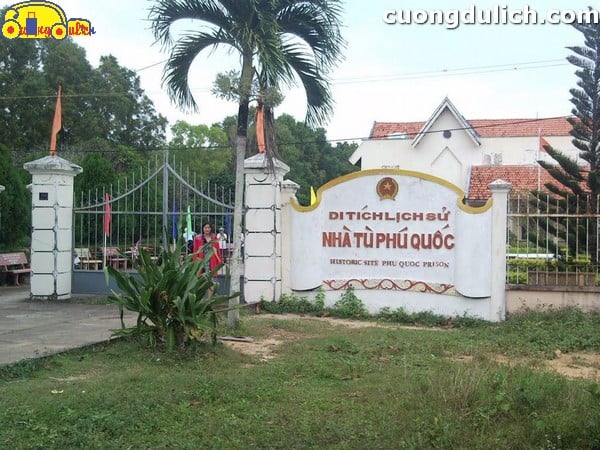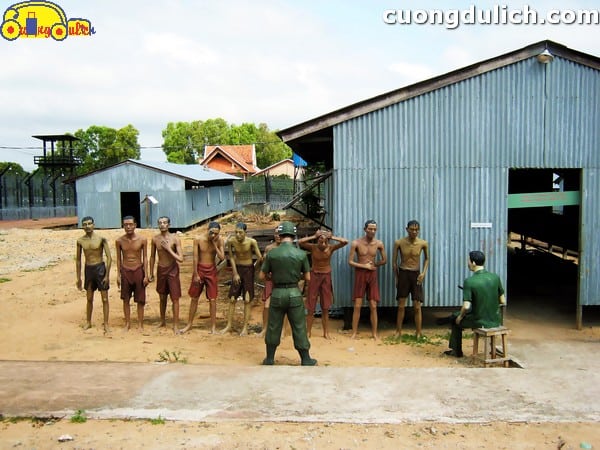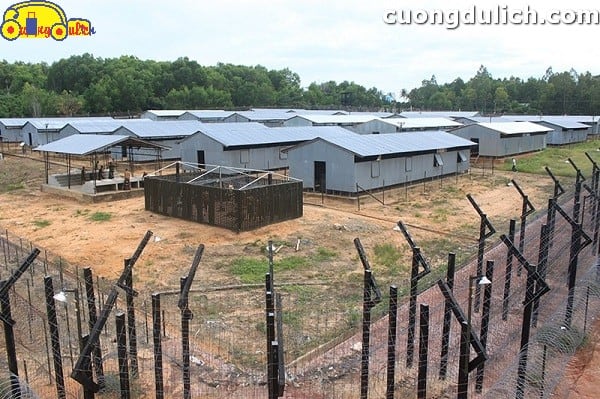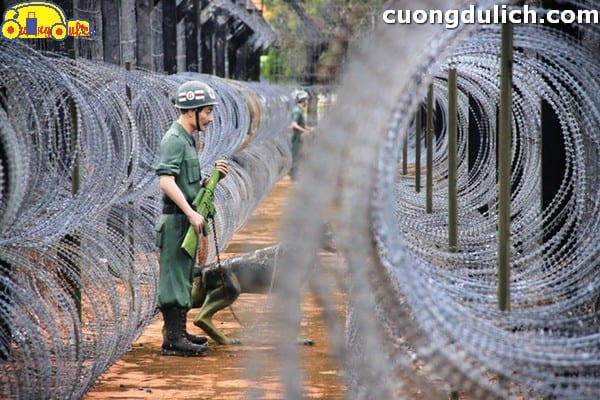If you have ever traveled to Phu Quoc and visited Phu Quoc Prison, you must have heard the tour guide or narrator talk a lot about the brutal torture scenes, horrifying stories, or even daring escape attempts at this Phu Quoc tourist spot. However, there are misconceptions about Phu Quoc Prison that hardly anyone has told you about. Even if you already know, you may not be aware of all the 5 terrifying misconceptions about Phu Quoc Prison below! To find out what these misconceptions are, watch this entire video by Cuong and you will understand!
1.Phu Quoc Prison is not Con Dao Prison
Perhaps due to the similarities between Con Dao Prison and Phu Quoc Prison, many tourists visiting Phu Quoc often mistake Phu Quoc Prison for Con Dao Prison. Many tourists booking Phu Quoc tours also request to visit Con Dao Prison, this is 100% true, Cuong Travel has had to explain the difference between these two prisons many times. Both of these prisons are places where war prisoners were held, historical relics, and located on remote islands, so almost 10 out of 10 tourists on a Phu Quoc tour inquire about their itinerary, 8 of them express a desire to visit Con Dao Prison. However, in Phu Quoc, there is only Phu Quoc Prison – known as the “earthly hell” that held thousands of patriotic prisoners during the war. Nevertheless, some tour groups with children, babies, or those visiting Phu Quoc during holidays may avoid Phu Quoc Prison. But Cuong Travel doesn’t see any issues with that. Those who wish to avoid it can stay outside or visit the Phung Hung fish sauce factory opposite the Coconut Tree Prison for shopping, while those interested in the country’s history can explore Phu Quoc Prison.
Phu Quoc Prison is located at 350 Nguyen Van Cu, An Thoi Commune, Phu Quoc District. This is one of the famous tourist attractions in Phu Quoc. Every year, Phu Quoc Prison welcomes over 10,000 visitors for tours.
Most tourists visit Phu Quoc Prison for various reasons. Some out of curiosity about the brutal torture of prisoners, some to learn about the heroic history of the nation during wartime, or simply because it’s part of the Phu Quoc tour program. But the most touching are the women who have relatives, fathers, grandfathers, and even husbands who were once imprisoned at Phu Quoc Prison. They come to find what remains, even if it’s just painful memories or a name engraved in the memorial house. In addition, former Phu Quoc prisoners who successfully escaped or were released after the country’s liberation also return. They seek to reunite with comrades who sacrificed in this earthly hell. Furthermore, it is worth noting that Phu Quoc Prison was put into operation after Con Dao Prison became overloaded. Each place carries its own pain. Therefore, remember that in Phu Quoc, there is only Phu Quoc Prison, not Con Dao Prison!
2. Phu Quoc Prison is a historical relic, it has ceased operations and is not a prison
For some travelers who have not learned about Phu Quoc tourism, they may mistakenly think that the Phu Quoc prison today is a detention center for lawbreakers on the island. In fact, it is true that the Phu Quoc prison is a place for imprisoning criminals. However, this is a matter of history, a place where patriotic prisoners dared to stand up and fight for national independence were captured and detained here.
The Phu Quoc prison is recognized as a national historical relic by the Ministry of Culture – Information in 1995. The historical relic of Phu Quoc prison is restored to recreate the history of the communist prisoner of war camp in Phu Quoc – the most vivid evidence of the atrocities of the colonial imperial regime. In addition, there is also a martyrs’ cemetery – where communist soldiers bravely sacrificed themselves before brutal torture, or a statue of holding hands – symbolizing the spirit of resilience and struggle of Phu Quoc prisoners against the oppression of invading forces.
This Phu Quoc tourism site is a vivid evidence of the extremely brutal crimes of the colonial regime, the invading imperial empire, while also reflecting the indomitable spirit of revolutionary soldiers. War prisoners at Phu Quoc prison had to endure very brutal punishments and torture such as nailing hands, feet, heads; burning red-hot zinc wires into flesh, pulling teeth, wrapping in soaked cloth with boiling water or pouring molten lead, throwing into boiling water, burning alive, burying alive… But with strong will, courage, and intelligence, they coped with them in many forms of struggle from low to high, dividing the enemy, eliminating evil, organizing escapes…
See more: Detailed Review of 16 Phu Quoc Tourism Sites
3. Phu Quoc Prison Built by the French – Used by the Americans but Governed by the Vietnamese
This is a long process in the history of the formation of Phu Quoc Prison. Originally a prison built by the French colonialists to detain patriotic Vietnamese, by 1967 with increased American intervention in the Vietnam War, the crackdown on patriotic soldiers increased. Therefore, the Saigon government rebuilt the Coconut Tree Prison, also known as the Phu Quoc Prisoner of War Camp, or the Phu Quoc Communist Prisoner Camp, on an area of about 400 hectares.
Specifically, Phu Quoc Prison went through the following periods:
Phu Quoc Prison during the French colonial period:
-In September 1946, the French colonialists returned to occupy Phu Quoc. They chose Phu Quoc to establish the largest prison in Southeast Asia, detaining revolutionary soldiers, as this island had a strategic military position, far from the mainland, far from media outlets to easily suppress prisoners. In 1953, the French used the military camp of the remnants of the Nationalist Party to build the prison, called Coconut Tree Prison. The prison covered an area of about 40 hectares, rectangular in shape, divided into four sections A, B, C, D. The entire camp was surrounded by thick barbed wire fences, with electric wires and guard lights above. Guard towers were regularly manned. Each gate had a squad of guards equipped with rifles. There were also combat posts outside. The number of prisoners during this period was about 6,000. By April 1954, there were about 14 thousand male prisoners. During the brutal French captivity and torture, the communist prisoners at Coconut Tree Prison fought bravely, vigorously supporting the revolutionary movement. During this time, 200 prisoners escaped and 99 died from torture.
-After the Geneva Accords, in July 1954, France handed over the prisoners and the management of the prison to the Democratic Republic of Vietnam. Coconut Tree Prison entered a new, more brutal and horrifying phase.
Phu Quoc Prison during the American-backed regime:
-After France handed over the prisoners and control of the prison to the government of the Democratic Republic of Vietnam. At the end of 1955, a new prison was built at the location of the old Coconut Tree Prison, covering an area of 4 hectares, named the Coconut Tree Re-education Camp or Coconut Tree Labor Camp. Unlike before, this prison was divided into male, female, and elderly prisoner sections. The camp covered an area of over 20,000 m2. It was surrounded by three layers of 2.6m high barbed wire fences. There were also 14 guard towers around the camp.
-Starting with dark days, on January 2, 1956, 598 prisoners from the Central Re-education Camp in Bien Hoa were transferred to Gia Dinh Prison. At Gia Dinh Prison, the 598 were processed and then taken aboard the transport ship Black River back to Phu Quoc. Later, additional political prisoners belonging to the “Viet Cong” or “pro-Communist” category were also brought to the Coconut Tree Re-education Camp for detention.
-After 7 months of detention (from February to September 1956), many escape attempts took place involving over 100 prisoners, some of whom were shot dead while trying to escape. Notable figures in this escape included Pham Van Khoe (brother of Pham Hung – the second Prime Minister of the Republic of Vietnam) and comrade Mai Thanh (Provincial Party Committee member, Secretary of the Rach Gia City Party Committee).
-Amidst this unrest, in 1957, the Republic of Vietnam transferred political prisoners from the “Coconut Tree Re-education Camp” to the mainland, with some sent to Con Dao Prison. As the Vietnam War escalated, the number of prisoners and political detainees increased. The Republic of Vietnam government built more prisoner of war camps in Bien Hoa, Pleiku, Da Nang, Can Tho, Quy Nhon… In Phu Quoc, the Republic of Vietnam government built another 400-hectare prison in the An Thoi Valley, 2 km away from the old Coconut Tree Camp.
4. Phu Quoc Prison site today is not original but reconstructed
The grounds of the Coconut Tree Prison historical site are not very spacious, but it can be said that this place has most authentically recreated the heroic evidence of the communist soldiers in the struggle for national independence. Whether in the indoor or outdoor exhibition areas, the original artifacts are still preserved and their positions remain almost unchanged, helping visitors to Phu Quoc experience and imagine most realistically the horrifying torture scenes at Phu Quoc Prison – known as hell on earth during the war, a place that leaves viewers astonished and horrified by the cruelty of the colonial and imperial regime.
The historical site of Phu Quoc Prison today is not large, located on the main area of the former prison, with a two-story exhibition building displaying artifacts and an outdoor exhibition area with original artifacts that are almost unchanged in position. Inside are rooms displaying and preserving artifacts, images of the prison, the brave sacrifices of communist prisoners, a documentary film room reenacting the brave struggle of the Phu Quoc communist prisoners, and the escape process of former prisoners here. Outside the Coconut Tree Prison are tiger cages, sharp barbed wire fences – where revolutionary spirits were imprisoned and the most brutal and cruel torture of communist prisoners was carried out, such as: nail embedding, light exposure, electric shocks, iron barrel rolling, skin piercing/burial alive, tooth extraction, and barrel beating.
In recent years, Kien Giang province has restored and preserved some construction items such as: 5 pre-prison buildings including a prison, dining hall, kitchen, and two guard houses; restoration of the underground escape tunnel, a section of barbed wire fence, guard posts, tiger cages, a memorial monument at the prisoner cemetery, and additional exhibition areas… to provide visitors to Phu Quoc with the most authentic view of this tourist destination.
Every year, the historical site of Phu Quoc Prison welcomes tens of thousands of visitors. They are former prisoners returning to revisit the place where they were once imprisoned; visitors of all ages from all over the country, especially young people when visiting Phu Quoc will surely visit this historical site; and foreign guests. Meanwhile, students from this island often come here to learn about the history of Phu Quoc and the resilient, indomitable struggle of the revolutionary soldiers.
5. Phu Quoc Prison detains but does not bury prisoners
Many tourists on Phu Quoc tours visiting the historical site of Phu Quoc Prison often fear ghosts, or think that there are mass graves in the prison, but in reality, the deceased in the prison were all taken to a nearby cemetery.
The prison at Phu Quoc has an area of 100m2, holding between 70 to 120 people, sometimes more. The prison was initially on the ground, but due to numerous escape attempts by prisoners, the Americans reinforced it with concrete floors, iron frames, and tin roofs, making it very hot during the day and cold at night. When crowded, people had to take turns lying down or sitting up.
Read more: 10 Tips for a Cheap 3-Day-2-Night Phu Quoc Tour
6. About Phu Quoc Prison
History of Phu Quoc Prison
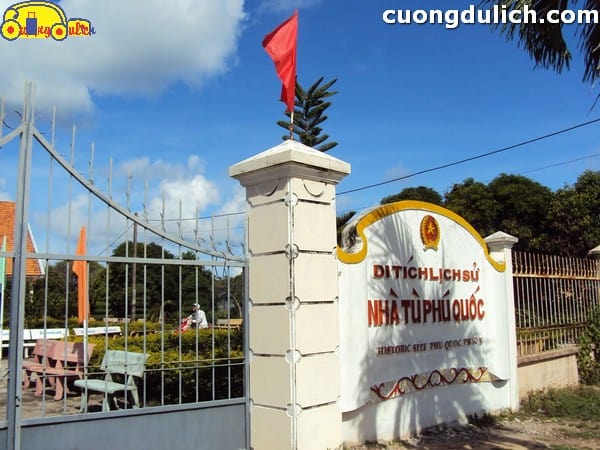
– In 1949, when the Chinese Nationalist Party lost to the People’s Liberation Army of China and fled to Vietnam, they were stationed by the French in the southern part of Phu Quoc Island. This force consisted of 30,000 soldiers, who later returned to Taiwan with Chiang Kai-shek. They left behind houses and plantations, which the French colonialists utilized to establish a prison covering about 40 hectares called “Coconut Tree Camp,” where they imprisoned nearly 14,000 prisoners of war. In July 1954, after the Geneva Accords, France handed over most of the prisoners at this camp to the Democratic Republic of Vietnam.
– At the end of 1955, Ngo Dinh Diem built a solid prison at the “Old Coconut Tree Camp” with an area of 4 hectares, dividing the prison into 3 areas: male prison, female prison, and elderly prison, named “Rehabilitation Coconut Tree Camp,” also known as Coconut Tree Labor Camp.
– In 1956, there were many prison escapes due to the unstable situation. In 1957, the Saigon government transferred the prisoners to the mainland and some to Con Dao.
– In 1966, as the Vietnam War escalated, the Republic of Vietnam government built many prisons in provinces such as Bien Hoa, Pleiku, Da Nang, Can Tho, Quy Nhon… In Phu Quoc, they built a 400-hectare prison in An Thoi Valley, 2km from the “Old Coconut Tree Camp,” divided into 4 zones: A, B, C, D with over 400 prison houses named “Vietnam Communist Prisoner Camp.” The prison was strictly managed by American advisors. Thus, Phu Quoc prison became a major detention center for the entire Republic of Vietnam, holding over 32,000 prisoners of war. In May 1969, prisoners successfully organized an escape in Zone B2.
– This prison applied the most brutal torture methods that prisoners had to endure, such as: nail pounding, tiger cage, eating tasteless food, iron bar rolling, barrel beating, tooth drilling, needle insertion, wrapping prisoners in bags and throwing them into boiling water,…
– In 1971, an investigator from the US Embassy in the Republic of Vietnam reported that the beating of prisoners at Phu Quoc prison was ongoing. After investigations by MACV and the US Embassy, General Cao Van Vien, the overall commander of the ARVN, affirmed that the international Red Cross inspection teams had reported inaccurately about the conditions at the prison.
– After the liberation in 1975, Phu Quoc prison was destroyed by the war.
– In 1995, the Ministry of Culture recognized Phu Quoc prison as a historical site and restored the prison camps, creating statues of tortured prisoners, so that future generations could see the cruelty of the regime at that time and the resilient spirit of the heroic Communist fighters.
– The historical site of Phu Quoc prison includes a statue of clasped hands, symbolizing “the symbol of severe oppression and the defiant spirit of Phu Quoc prisoners.”
Historical significance of Phu Quoc prison
Phu Quoc prison – one of the most visited national monuments by both domestic and international tourists. If Son La prison embodies the brutal war years of our people against the French colonial regime, then in a remote and rich natural area of the pearl island, the atrocities of the US empire are preserved at Phu Quoc prison. In 1944, the French colonialists arrested and imprisoned patriotic people on Phu Quoc Island. At that time, the area consisted of only 3 prisons, on a small scale. By 1953, the Coconut Tree Camp – the name of the prison that the colonialists built to imprison officials and soldiers from all three regions of North, Central, and South Vietnam. After relentless resistance of our nation, the prison was officially dissolved and freedom was granted to patriotic soldiers and officials. This was also when the Geneva Accords were signed. In 1967, the US government officially rebuilt the prison, named “Vietnam Communist Prisoner Camp” or “Phu Quoc War Prisoner Camp” to detain and torture a large number of revolutionary soldiers of Vietnam. With 12 detention zones and nearly 500 prison houses, many heroes, patriotic soldiers were arrested and brutally interrogated. The most extreme torture methods were used to subdue the fighting spirit and patriotism of the Vietnamese people. The US empire did not hesitate to commit any crime to achieve its goals, at times imprisoning nearly 40,000 people there, surrounded by barbed wire fences with a system of lights shining everywhere. The paintings depicting those brutal torture scenes partly accuse the crimes of the US empire at that time. Fortunately, among the survivors, they recounted: “every time new prisoners were brought in, they were all beaten on the head to break their fighting spirit, then taken out to be exposed to the scorching sun, beaten.” During interrogation to extract information about our army, our soldiers steadfastly refused to submit. In that situation, the prison used sticks to smash the toes and fingers of prisoners to threaten and force confessions. In the cramped, damp space of the prison, many infectious diseases spread. Like a strategy forcing our people to surrender to their cruelty, the fighting spirit of our nation became stronger than ever.
It is impossible to fully recount the atrocities committed by the colonialists, empires against our people, Phu Quoc prison today is the most vivid embodiment of the history of the Vietnamese people as well as international visitors understanding a part of Vietnamese history.
Guide to visiting Phu Quoc prison
- About the infrastructure of Phu Quoc prison
When visiting Phu Quoc tourism, tourists will explore the infrastructure of the prison. Phu Quoc prison is very spacious with an area of up to 400 hectares; it has nearly 500 houses divided into 12 zones. Each zone has tiger cages; isolation cells to guard prisoners.
- Highlights of Phu Quoc prison
Zone B2 is a place that recreates the old Phu Quoc prison; with effigies of prisoners and soldiers creating a realistic experience for visitors. Tourists can see, hear, and feel the physical and mental pain of the prisoners imprisoned here. Here, the colonial regime used over 40 brutal torture methods to torment prisoners, revolutionary soldiers.
First, the tiger cage with barbed wire. Prisoners had to lie in a cage under the sun with an area of only 2m in length; 0.5m in width. Surrounded by spikes, prisoners could not move. This was one of the most brutal torture methods. Next is the isolation cell. Here, the scene of the enemy torturing prisoners with nails, burying alive, nailing into the head, boiling in hot water, drilling prisoners’ teeth,…Due to the extremely brutal oppression and torture, many struggles and prison breaks emerged. The images of Vietnamese prisoners digging tunnels through the camp were found and vividly recreated.
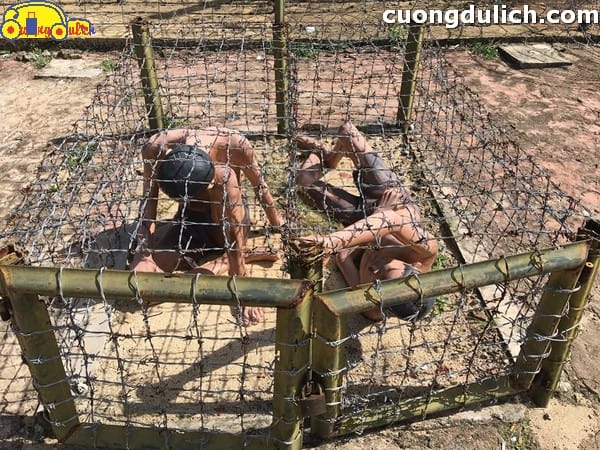
Things to Note When Visiting Phu Quoc Prison
- How to Get to Phu Quoc Prison
Phu Quoc Prison is located on Provincial Road 46, 28 km south of Duong Dong town center and 2 km from Bai Khem tourist area. For the most convenient way to visit combined with other locations, you should choose a motorbike rental service. You can rent a bike in the center of Duong Dong town. There are many rental shops here to serve tourists. Or you can book a Phu Quoc tour package to Phu Quoc Prison to avoid worrying about transportation.
- Best Time to Visit Phu Quoc Prison?
You should visit around November to June next year because during this time Phu Quoc has a cool and less rainy climate. Very convenient for frequent travel and outdoor activities.
Costs When Visiting Phu Quoc Prison
Visitors do not have to pay an entrance fee. However, if you need a guide, you will have to pay around 100,000 to 200,000 VND for a more detailed introduction and information. This is not mandatory, so if you feel necessary, you can hire a guide, otherwise you can explore and learn on your own, as there are explanations in each area!
- Opening Hours
Phu Quoc Prison is open from 8:00 am to 11:30 am and from 1:30 pm to 5:00 pm on the same day. So pay attention to only visit and travel here during the day. In fact, you can visit the historical site at any time, but during the lunch break, the guide service also takes a break, so please note.
So pay attention to what to do and don’t miss out on this place if you arrive too late! In addition, the duration of visiting Phu Quoc Prison is also somewhat limited, only about 1-2 hours per visitor. However, personally, I think this is a relatively reasonable amount of time and you don’t need too much time to explore this place.
- Dress Code
Although it is one of the Phu Quoc tourist destinations, as a historical site, it has its own solemn and dignified features, so it would be more appropriate if you wear formal attire, avoid wearing overly revealing clothes, and also maintain a sense of respect while moving around.
- Other Notes
-Do not touch or disturb the displayed artifacts and related items, some clay statues need to be restored and preserved!
-Also, bringing food and drinks is quite necessary, but after use, make sure to dispose of trash in the designated areas to not affect the general hygiene of the historical site of Phu Quoc Prison.
-Phu Quoc Prison has a gift shop and a snack shop. If you want to buy souvenirs or snacks, you can visit here.
-Above the prison is a war memorial, depicted by giant blue waves. There is also the shape of an empty human figure.
-It will take about 1-2 hours to thoroughly explore the Phu Quoc Prison complex
-There are other prisons along Nguyen Van Cu street. However, they are not set up for tourism.
-There is also a fish sauce factory near the prison that you can visit
-Most tour operators include Phu Quoc Prison in their tour itineraries
-There is a souvenir shop next to the prison selling souvenirs and dried fish
Forms of Torture at Phu Quoc Prison
– Zinc barbed wire cage: a cage made entirely of barbed wire, placed outdoors, they make many types of cages, prisoners cannot stand up or sit down. And they force the prisoners to take off all their clothes and only wear shorts to endure rain and sun all day and night.
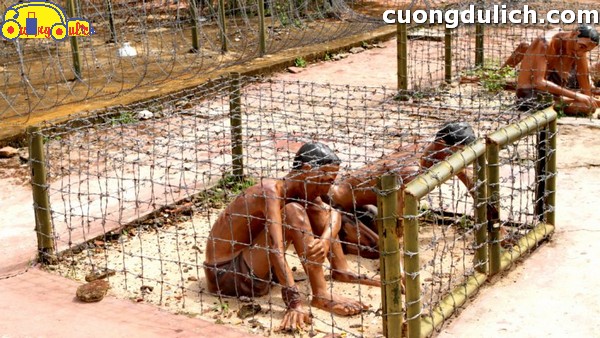
– Đóng đinh: Chúng dùng những chiếc đinh 3 phân, 7 phân để đóng vào ngón tay, các khớp xương cổ, đầu gối, … để tra tấn. Sau khi bị đóng đinh thì xương của người tù sẽ vỡ vụn ra.
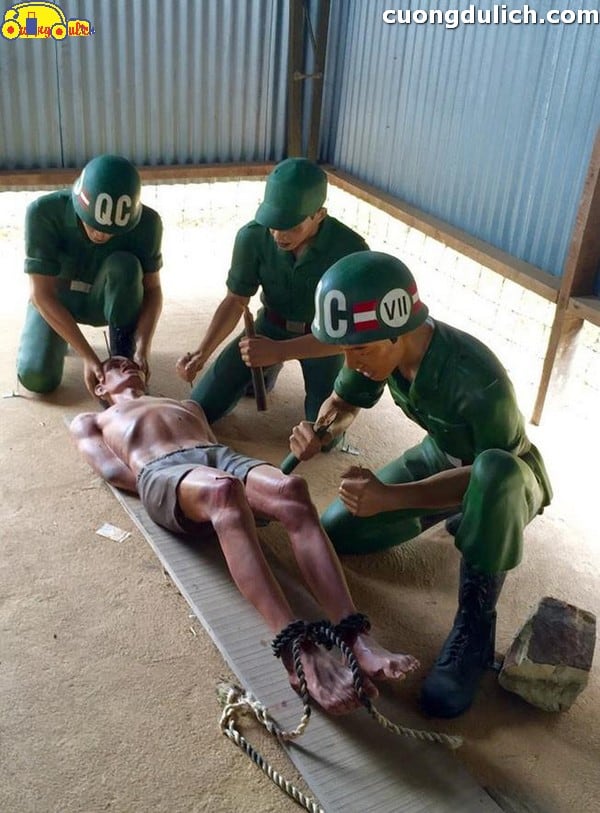
– Using high-pressure lamps to shine into the eyes of prisoners until they explode: Prisoners are placed lying on a chair, then a high-pressure lamp is placed directly on the prisoner’s eyes. The guards at Phu Quoc prison force the prisoners to open their eyes wide and shine the lamp inside for a long time, until the eyes are so ripe that they explode.
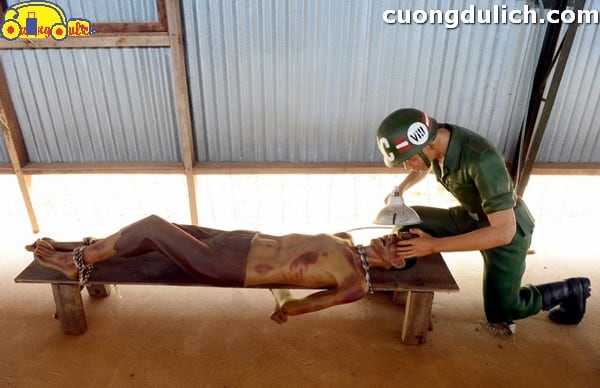
– Iron bar flipping: They make prisoners take off their shirts, flip their heads on a long iron bar, full of sharp iron pieces stuck together. After a few flips, the prisoner’s back will bleed, skin will peel off…
– Put into a barrel full of water: A prison guard at Phu Quoc prison presses the prisoner’s head down into the water-filled barrel, while another person uses a hammer to hit the barrel hard, causing many prisoners to have their ears burst, spewing water until death. If someone has ever shouted into your ear, you must have felt a severe headache, right? Imagine that pain multiplied a thousand times, and you will be able to imagine what the prisoners have to endure.
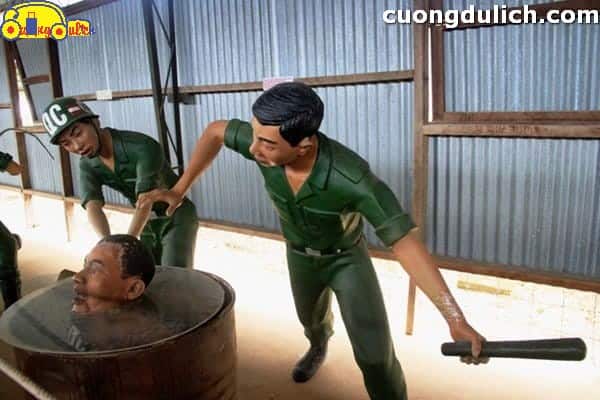
– Extracting teeth is one of the torture methods considered the lightest among the 24 torture techniques devised to torture prisoners at Phu Quoc prison. A small stick is placed on the prisoner’s tooth, then a hammer is struck on the stick. To extract an upper tooth, hit downwards, to extract a lower tooth, hit upwards. Once the tooth falls out, the prisoner must immediately swallow the blood, some are even forced to swallow the tooth down to the stomach. When witnessing that scene, one instinctively raises their hand to check if their teeth are still intact. Anyone who has had a tooth extracted surely remembers how excruciating that pain is, yet the prisoners at Phu Quoc prison have to endure having multiple teeth extracted at once, two, three, or even up to ten teeth at a time, which must be a pain multiplied a thousand times.

–Boiling prisoners alive: Another gruesome form of torture, seemingly only from medieval times, is boiling prisoners alive. The prison guards at Phu Quoc prison would put the prisoners in a sack, then throw them into a pot of boiling water. If any of us have ever been scalded by boiling water, we know how excruciatingly painful and sensitive the burnt area becomes, even if it’s just a very small part of the body. It’s unimaginable how intense the pain would be when the entire body is submerged in boiling water. Despite the excruciating burns, the prisoners remained resolute, not showing any signs of pain or crying out, forcing the guards to despise their torture methods.
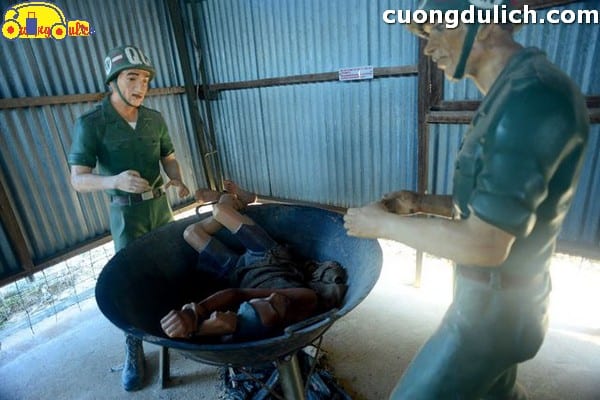
In addition, there are many other forms of torture such as stuffing into a sack and then putting into a hot pan, hanging upside down and beating, electric shocks, or even burying alive,…
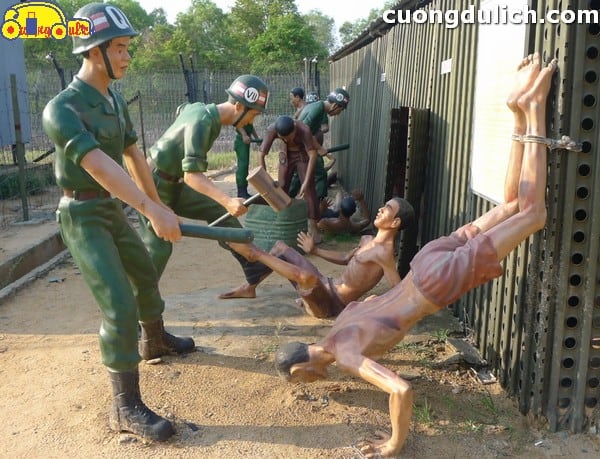
In less than 8 years (6/1967 – 3/1937), over 4000 people died, thousands were injured, and dozens were disabled at Phu Quoc prison. Outraged by their cruelty, the prisoners attempted multiple escapes. Particularly, on 26/1/1969, 24 prisoners successfully escaped through a tunnel they dug with spoons over 4 months. This escape was considered a miraculous and remarkable event at the largest prison in Vietnam at that time.
Today, the war has passed, the past is closed, but within the hearts of the surviving revolutionaries and our people, there remains a haunting fear of the cruelty of the colonialists and empires. However, through this, we admire even more the unwavering courage of the revolutionaries.
Phu Quoc prison is the most vivid depiction of the brutality of the enemy during the turmoil. By visiting Phu Quoc prison, hearing stories, and observing images and artifacts that recreate the horrifying scenes the prisoners endured, visitors can truly appreciate the courage, resilience, and heroic sacrifice of the revolutionaries in the arduous struggle for national independence. It is also a place where visitors can witness the cruelty of the colonial empires in their invasive wars. From there, we grow to love our country more, remember the sacrifices of those who came before us for national independence. Hopefully, with these insights, you will have a meaningful experience when visiting Phu Quoc and exploring Phu Quoc prison.

